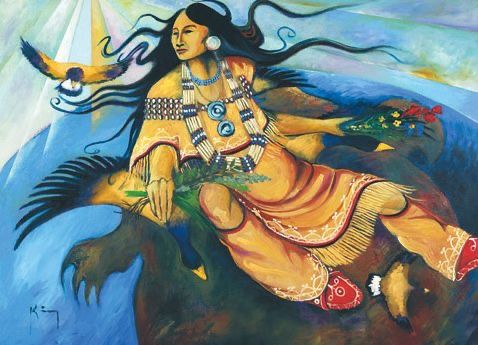Our country's 50,000-year-old encyclopedia<br /> by [[Margaret Burin]], [[Chris Lewis]] in ABC News accessed on 2025-11-11T08:50:57
via A 50,000 year old community PKMS : r/PKMS<br /> by [[WadeDRubicon]]<br /> accessed on 2025-11-11T08:50:16
Our country's 50,000-year-old encyclopedia<br /> by [[Margaret Burin]], [[Chris Lewis]] in ABC News accessed on 2025-11-11T08:50:57
via A 50,000 year old community PKMS : r/PKMS<br /> by [[WadeDRubicon]]<br /> accessed on 2025-11-11T08:50:16

Windigo Norval Morrisseau, Windigo, tempera on brown paper, ca. 1963.(courtesy Glenbow Museum/64.37.9)
via The Canadian Encyclopedia<br /> https://www.thecanadianencyclopedia.ca/en/article/windigo
https://libguides.marist.edu/c.php?g=1314310&p=9677364

Artwork mentioned by Robin Wall Kimmerer in Braiding Sweetgrass.
Logging some keywords here for later cross referencing.
The linocut medium is especially prevalent in the Torres Strait,where a handful of pioneering artists have mastered the art of printmaking (Robinson2001)
Art is often focused on aesthetic, but more importantly, it is avisual embodiment of knowledge.
link to: Eddington quote https://hypothes.is/a/TNV2WqfpEe2Z24NgnWsZCg
And yes, it is also very pretty.
understated quote of the day
Hamacher, Duane W. “The Art of Star Knowledge.” In 65,000 Years: A Short History of Australian Art, edited by Judith Ryan and Marcia Langton. Melbourne, Australia: University of Melbourne Press, 2023. https://www.academia.edu/96537139/The_Art_of_Star_Knowledge.
Bacon, Bennett, Azadeh Khatiri, James Palmer, Tony Freeth, Paul Pettitt, and Robert Kentridge. “An Upper Palaeolithic Proto-Writing System and Phenological Calendar.” Cambridge Archaeological Journal, January 5, 2023, 1–19. https://doi.org/10.1017/S0959774322000415.
There may be questions as to whether or not this represents written language, but, if true, this certainly represents one of the oldest examples of annotation in human history!
cc: @remikalir
“I think it’s such a fascinating story,” Martin said. He also appreciated collecting in an area where there wasn’t a huge amount of established scholarship. “It’s fun to have something to study, to try to understand, to apply your critical eye to without any outside pressure,” he added. “There’s not a lot of promotion about [these] artists. You just have to find it out yourself.”
Reading and studying it all without any regard to the Indigenous culture. Steve Martin is using Western perspectives to attempt to understand non-Western art which has a different basis.
https://news.artnet.com/art-world/steve-martin-indigenous-art-national-arts-club-2180438
Groups in arts education rail against the loss of music, dance, and art in schools and indicate that it's important to a balanced education.
Why has no one embedded these learning tools, for yes they can be just that, into other spaces within classrooms? Indigenous educators over the millennia have done just this in passing on their societal and cultural knowledge. Why have we lost these teaching methods? Why don't we reintroduce them? How can classrooms and the tools within them become mnemonic media to assist both teachers and learners?
Perhaps we need to bring back examples of how to do these things at the higher levels? I've seen excercises in my daughter's grade school classrooms that bring art and manipulatives into the classroom as a base level, but are they being done specifically for these mnemonic reasons?
Michael Nielsen and Andy Matuschak have been working at creating a mnemonic medium for areas like quantum mechanics relying in part on spaced repetition. Why don't they go further and add in dance, movement, art, and music to aid in the process. This can be particularly useful for creating better neurodiverse outcomes as well. Education should be more multi-modal, more oral, and cease it's unending reliance on only literacy as it's sole tool.
How and where can we create a set of example exercises at various grade levels (similar to rites of knowledge initiation in Indigenous cultures, for lack of specific Western language) that embed all of these methods
Link to: - Ideas in The Extended Brain about movement, space, etc. - Nielsen/Matuschak mnemonic media work
https://www.youtube.com/watch?v=kkjf0hCKOCE
The sky is a textbook. The sky is a lawbook. The sky is a science book. —Duane Hamacher, (1:24)
Hamacher uses the Western description "method of loci" rather than an Indigenous word or translated word.
The words "myth", "legend", "magic", "ritual", and "religion" in both colloquial English and even anthropology are highly loaded terms.
Words like "narrative" and "story" are better used instead for describing portions of the Indigenous cultures which we have long ignored and written off for their seeming simplicity.
For Aboriginal Australians,its importance is recognised by its position at the centre of thenational Aboriginal flag, developed in 1971 by Luritja artist HaroldThomas.
The Aboriginal flag was developed in 1971 by Luritja artist Harold Thomas. Centering its importance to Aboriginal Australians, the sun appears in the middle of the flag.
It's subtle here, as in other instances, but notice that Hamacher gives the citation to the Indigenous artist that developed the flag and simultaneously underlines the source of visual information that is associated with the flag and the sun. It's not just the knowledge of the two things which are associated to each other, but they're also both associated with a person who is that source of knowledge.
Is this three-way association common in all Indigenous cultures? While names may be tricky for some, the visual image of a particular person's face, body, and presence is usually very memorable and thereby easy to attach to various forms of knowledge.
Does the person/source of knowledge form or act like an 'oral folder' for Indigenous knowledge?
A nice overview of indigenous art in Australia from about the 1940's until today. Some fantastic pieces in here.
“El Güegüense o el Macho Ratón” is one of the oldest of the handful of literary works from popular indigenous culture that have survived from Latin America's European dominated colonial era. Essentially a piece of street theater conceived in the indigenous Nahualt language, it combines music, dance, dialogue and masquerade portraying the interaction of an indigenous merchant with a Spanish colonial official.